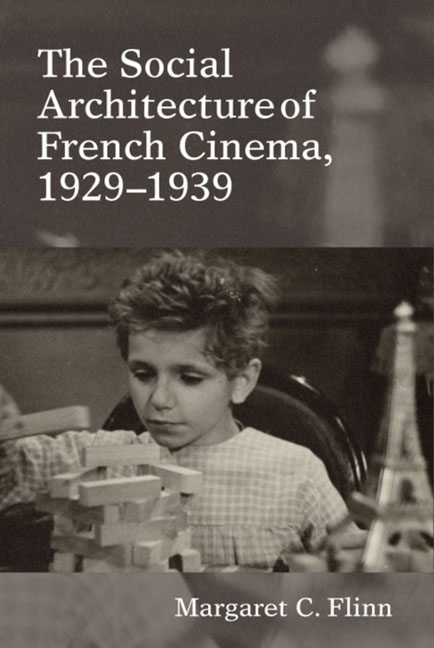Book contents
- Frontmatter
- Contents
- List of Illustrations
- Acknowledgements
- Introduction: An Architecture of Social Being
- 1 The Spatial Constitution of 1930s Documentary
- 2 René Clair's City Views: Realism and Studio Paris
- 3 Intertext and Political Margins in Jean Renoir's Boudu sauvé des eaux
- 4 Traversing Built History in Architectural Documentaries
- 5 Flâneuses and the Unmaking of Place
- 6 The Crowd as New Monumentality during the Popular Front
- Epilogue: Poetic Realism as Spatial Fable
- Notes
- Bibliography
- Filmography
- Index
2 - René Clair's City Views: Realism and Studio Paris
- Frontmatter
- Contents
- List of Illustrations
- Acknowledgements
- Introduction: An Architecture of Social Being
- 1 The Spatial Constitution of 1930s Documentary
- 2 René Clair's City Views: Realism and Studio Paris
- 3 Intertext and Political Margins in Jean Renoir's Boudu sauvé des eaux
- 4 Traversing Built History in Architectural Documentaries
- 5 Flâneuses and the Unmaking of Place
- 6 The Crowd as New Monumentality during the Popular Front
- Epilogue: Poetic Realism as Spatial Fable
- Notes
- Bibliography
- Filmography
- Index
Summary
Fiction or reality? Méliès or Lumière? In our memory, the real world where we thought we lived mingles with the world of illusion.
—René ClairIf Paris didn't exist, René Clair would certainly have invented it.
—Georges AltmanIn the early 1930s, René Clair made a series of films with cameraman Georges Périnal and set designer Lazare Meerson: Sous les toits de Paris in 1930, Le Million and À nous la liberté in 1931, and Quatorze juillet in 1932. In this chapter I will show how these studio films of the early 1930s develop a strain of realism—albeit one mixed with or in constant tension with fantasy—based on spatial verisimilitude. Clair's realism is in no small part due to set design, which, as Tim Bergfelder, Sue Harris, and Sarah Street have suggested in Film Architecture and the Transnational Imagination, provides a film
with its inimitable look, its geographical, historical, social, and cultural contexts and associated material details, and the physical framework within which a film's narrative is to proceed. Beyond these qualities, sets aid in identifying characters, fleshing out and concretizing their psychology; and, often in conjunction with other contributing elements such as music and lighting, they help in creating a sense of place in terms of “mood” or “atmosphere,” and thus evoke emotions and desires that complement or run counter to the narrative.
As Bergfelder, Harris, and Street go on to suggest, set design is never solely responsible for the effect, look, meaning, or narrative of a film, but operates in conjunction with mise en scène, editing, acting, costuming, etc.
In the case of Clair, the collaboration with Périnal and Meerson was extraordinarily fruitful, both in the changes it brought to what became known as Clair's signature, and to cinema as a whole. R.C. Dale remarks particularly upon the introduction of a new fluidity in camerawork— precisely when cumbersome sound equipment would make such fluidity counterintuitive. Meanwhile, Lazare Meerson's sets—particularly the exteriors—set a new standard for imagining “Paris.” Perhaps the studio Paris closest to popular memory today—as evidenced by criticism of nostalgia in the 2001 film by Jean-Pierre Jeunet, Le Fabuleux destin d'Amélie Poulain —is in fact that of a different director–set designer collaboration.
- Type
- Chapter
- Information
- The Social Architecture of French Cinema1929–1939, pp. 39 - 57Publisher: Liverpool University PressPrint publication year: 2014



